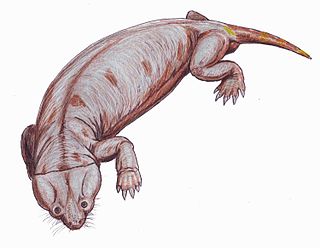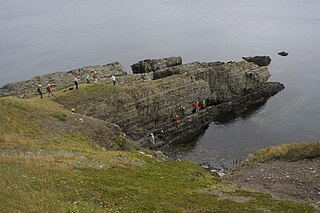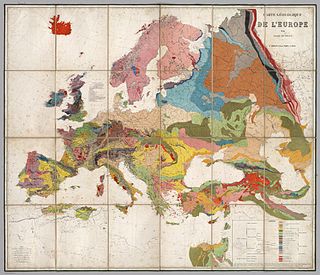In chronostratigraphy, a stage is a succession of rock strata laid down in a single age on the geologic timescale, which usually represents millions of years of deposition. A given stage of rock and the corresponding age of time will by convention have the same name, and the same boundaries.
A stratigraphic unit is a volume of rock of identifiable origin and relative age range that is defined by the distinctive and dominant, easily mapped and recognizable petrographic, lithologic or paleontologic features (facies) that characterize it.

Lithostratigraphy is a sub-discipline of stratigraphy, the geological science associated with the study of strata or rock layers. Major focuses include geochronology, comparative geology, and petrology. In general a stratum will be primarily igneous or sedimentary relating to how the rock was formed.
In the geological timescale, the Berriasian is an age or stage of the Early Cretaceous. It is the oldest, or lowest, subdivision in the entire Cretaceous. It spanned the time between 145.0 ± 4.0 Ma and 139.8 ± 3.0 Ma. The Berriasian succeeds the Tithonian and precedes the Valanginian.
The Danian is the oldest age or lowest stage of the Paleocene epoch or series, the Paleogene period or system and the Cenozoic era or erathem. The beginning of the Danian age is at the Cretaceous–Paleogene extinction event 66 Ma. The age ended 61.6 Ma, being followed by the Selandian age.
The Priabonian is, in the ICS's geologic timescale, the latest age or the upper stage of the Eocene epoch or series. It spans the time between 37.8 and33.9 Ma. The Priabonian is preceded by the Bartonian and is followed by the Rupelian, the lowest stage of the Oligocene.
The Chattian is, in the geologic timescale, the younger of two ages or upper of two stages of the Oligocene epoch/series. It spans the time between 28.1 and23.03 Ma. The Chattian is preceded by the Rupelian and is followed by the Aquitanian.
Chronostratigraphy is the branch of stratigraphy that studies the age of rock strata in relation to time.

The Cistecephalus Assemblage Zone is a tetrapod assemblage zone or biozone found in the Adelaide Subgroup of the Beaufort Group, a majorly fossiliferous and geologically important geological group of the Karoo Supergroup in South Africa. This biozone has outcrops located in the Teekloof Formation north-west of Beaufort West in the Western Cape, in the upper Middleton and lower Balfour Formations respectively from Colesberg of the Northern Cape to east of Graaff-Reinet in the Eastern Cape. The Cistecephalus Assemblage Zone is one of eight biozones found in the Beaufort Group, and is considered to be Late Permian in age.
Chronozone or chron is a term used for a time interval in chronostratigraphy, defined by events such as geomagnetic reversals (magnetozones), or based on the presence of specific fossils . According to the International Commission on Stratigraphy, the term "chronozone" refers to the rocks formed during a particular time period, while "chron" refers to that time period.
In paleontology, biochronology is the correlation in time of biological events using fossils. In its strict sense, it refers to the use of assemblages of fossils that are not tied to stratigraphic sections. Collections of land mammal ages have been defined for every continent except Antarctica, and most are correlated with each other indirectly through known evolutionary lineages. A combination of argon–argon dating and magnetic stratigraphy allows a direct temporal comparison of terrestrial events with climate change and mass extinctions.
In biostratigraphy, a local-range zone, topozone or teilzone is the stratigraphic range of the rock unit between the first and last appearance datum of a particular taxon in a local area. It is a subset of the global biozone for that taxon. For the teilzone data to be meaningful, the local area must be identified. The term was coined in 1914 by German paleontologist and geologist Josef Felix Pompeckj.
Angonisaurus is an extinct genus of kannemeyeriiform dicynodont from the Late Triassic of Africa somewhere between 251 million years ago and 199 million years ago. Only one species, Angonisaurus cruickshanki has been assigned to this genus. This genus is thought to have been widely spread but rare in southern Gondwana. Though few in number, the fossil record of Angonisaurus cruickshanki contains multiple specimens giving it a measurable stratigraphic range. Sexually dimorphic features are found in Angonisaurus which include presence or absence of tusks and difference is size and robustness of the temporal arch and the rostral.
The Norian is a division of the Triassic geological period. It has the rank of an age (geochronology) or stage (chronostratigraphy). The Norian lasted from ~227 to 208.5 million years ago. It was preceded by the Carnian and succeeded by the Rhaetian.

The Terreneuvian is the lowermost and oldest series of the Cambrian geological system. Its base is defined by the first appearance datum of the trace fossil Treptichnus pedum around 541 million years ago. Its top is defined as the first appearance of trilobites in the stratigraphic record around 521 million years ago. This series was formally ratified by the International Commission on Stratigraphy in 2012.
Cambrian Series 2 is the unnamed 2nd series of the Cambrian. It lies above the Terreneuvian series and below the Miaolingian. Series 2 has not been formally defined by the International Commission on Stratigraphy, lacking a precise lower boundary and subdivision into stages. The proposed lower boundary is the first appearance of trilobites which is estimated to be around 521 million years ago.
In geology, range offset is the time difference between the last fossil occurrence of a taxon and the actual disappearance of this taxon. Range offset can be used as a measure of biostratigraphic precision and determines among others how much information about extinctions can be derived from fossil occurrences.
Stratigraphic paleobiology is a branch of geology that is closely related to paleobiology, sequence stratigraphy and sedimentology. Stratigraphic paleobiology studies how the fossil record is altered by sedimentological processes and how this affects biostratigraphy and paleobiological interpretations of the fossil record.




